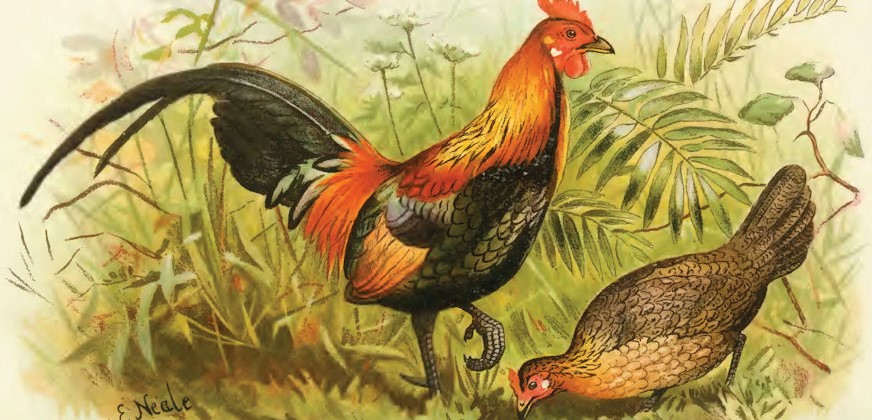The forefathers of today’s chickens were the bankiva chickens from Southeast Asia. They looked like those in the drawing shown here.
They lived in the forest and on the edge of the forest. Every day they foraged for food in a limited and sheltered area in a family group. Their food included grass, slugs, clover, worms, herbs and beetles, anything they could find at the edge of the forest. This small flock of chickens would consist of 7 – 20 hens and a rooster.
The rooster took good care of his chickens. When danger threatened he would warn them so they could quickly take cover in the forest. Sometimes he would even do battle if other animals intruded. It was also his task to settle disputes, to lead the flock to good feeding grounds or to accompany them to the nesting place.
At dusk they flew up onto a branch to roost. The safest places were right at the top, so these places were instinctively the most sought after.
At that time every hen laid about 20 eggs a year. When a hen was broody, she would build nests in various places and lay eggs in each one. Then she would incubate a clutch which had not been found by predators and was therefore the safest. The hen must be prepared to sit on the 8-15 eggs almost continuously for 21 days for the chicks to hatch, providing, of course, that the rooster has fertilised the eggs beforehand. Chickens have a clever solution to this problem, the rooster does not have to mount the hen to fertilise each egg, but the sperm is stored in the so-called infundibulum inside the hen and can be released for a number of eggs until she is mounted again.
As soon as the chicks hatch, the mother hen takes them under her wing, shows them good feeding places, warms and protects them. As precocial birds, the chicks can already do a lot on their own. For example, they instinctively recognize a shiny drop of water or puddle as a water source and peck at it.
3,000 years ago, man entered the chicken world. At the beginning they were kept as domestic animals close to human dwellings. They were fed and protected , and in return the eggs were taken as food.
The longer hens and humans have co-existed, the more humans have paid attention to the laying performance or weight gain propensity of particular hens. These animals were then selected as parent animals and so breeding began.







